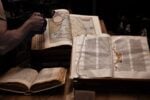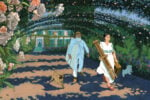An Entertainment in Conversation and Verse
.jpg)
Il titolo An Entertainment in Conversation and Verse è preso in prestito da Ronald David Laing che così sottotitolava il suo Mi ami?, libro in cui lo psichiatra scozzese utilizza anche la sua biografia familiare come oggetto dell’indagine, sostituendo il discorso teorico con quello poetico.
Comunicato stampa
La Galleria Tiziana Di Caro è felice di ospitare An Entertainment in Conversation and Verse una mostra collettiva curata da Maria Adele Del Vecchio che include opere di Maria Adele Del Vecchio, Gaia Di Lorenzo, Sara Enrico, Giovanni Giaretta, Andy Holden, Thomas Jeppe, Ninon Liotet, Eleonora Meoni, Pentti Monkkonen, Marta Orlando, Francesco Pedraglio, Benedicte Gyldenstierne Sehested e inaugura mercoledì 21 giugno 2017 dalle ore 19:00 alle ore 21:30.
Il titolo An Entertainment in Conversation and Verse è preso in prestito da Ronald David Laing che così sottotitolava il suo Mi ami?, libro in cui lo psichiatra scozzese utilizza anche la sua biografia familiare come oggetto dell'indagine, sostituendo il discorso teorico con quello poetico. Maria Adele Del Vecchio ponendosi in una doppia prospettiva (artista - curatore), mette in moto uno spostamento di ruoli e ci offre un punto di vista eterogeneo che non riguarda solo la sua opera inclusa nel progetto, ma anche il suo rapporto con gli artisti invitati e la relativa scelta delle loro opere: "L'oggetto del mio sguardo diventa il soggetto che mi guarda, in poche parole l'opera d'arte ha funzione costitutiva in rapporto alla mia identità: da spettatore - forse giudice - entro a mia volta in un campo visivo, quello dell'opera, e questo ingresso comporta la riscrittura del processo di soggettivazione".
In questa ottica Del Vecchio concepisce un'opera che attraverso il palindromo Are we not drawn onward to new era, crea un continuo movimento di rimandi e di punti di vista, che pur ribaltandosi non ne compromette il senso. L'inizio del percorso espositivo è caratterizzato da un racconto ipnotico e indecifrabile. Si tratta della voce fuoricampo del video di Giovanni Giaretta, The Sailor. Ispirato da Il Marinaio di Fernando Pessoa, il video è in Na'vi, una lingua inventata per il film di fantascienza Avatar, e racconta la storia di un marinaio che immagina una patria che non ha mai avuto. Un processo lento e in risposta al contesto della galleria e della città di Napoli ha caratterizzato la realizzazione delle sculture di Gaia Di Lorenzo che, in continuità con la propria pratica, cerca nelle cose i loro opposti - il fragile nel duro, il naturale nell'artificiale… - senza privilegiare uno dei due aspetti, ma rendendoli complici. Così come Gaia Di Lorenzo, anche Thomas Jeppe ha tratto spunto da Napoli per realizzare un dipinto in cui Alessandro Moreschi, l'ultimo evirato della storia, si confronta con il suo fantasma in un paesaggio ispirato alla città partenopea.
Cut out è una scultura di Sara Enrico che fa parte di una serie caratterizzata da volumi delicati, apparentemente precari, e da lavorazioni di superficie. Nei dettagli e nelle posture di questi oggetti l'artista ricerca una dimensione antropomorfa, vulnerabile. Una porzione di universo si vede nell'opera di Andy Holden; fra le stelle scorgiamo una serie di occhi che restituiscono lo sguardo di chi osserva, confondendo il ruolo dello spettatore e quello dell'oggetto osservato.
Pentti Monkkonen ritrae la tipica facciata di un palazzo berlinese sulla quale colloca un murale che ritrae Britney Spears nel momento del suo famoso crollo psichico. Ancora una volta si rinnova l'idea del rimando di sguardi che rapisce lo spettatore. Un elemento che in qualche modo si presenta nuovamente nell'aspetto ieratico della scultura di Benedicte Gyldenstierne Sehested, che ritroviamo anche nelle sue fotografie; si tratta di soggetti dall'identità ambigua che l'artista raggruppa focalizzandosi sulla loro presenza psicologica ed emotiva in una struttura sociale condivisa. L'opera di Ninon Liotet indaga l'incidenza che il suono, nel caso specifico quello di una casa che brucia, può evocare nella coscienza dello spettatore. Da premesse affini nasce l'interazione di Eleonora Meoni con lo spazio espositivo: l'artista interviene sui neon della galleria, scolpendo l'ambiente attraverso l'uso del colore.
Un segmento più intimo ed emozionale caratterizza l'opera di Marta Orlando in cui la tela si trasforma in una lavagna su cui sono ben visibili le tracce delle cancellature, laddove l'atto di scrivere e riscrivere, "una sorta di mantra senza fine", rievoca la continua, spesso necessaria, ricostruzione del sé. La mostra si completa con una performance di Francesco Pedraglio che consiste nel racconto di una serie di storie in relazione a delle immagini che nell'arco della serata verrano sostituite, spostate, inter - cambiate, dando vita sempre a nuove possibilità narrative e visive.
"Ho invitato artisti le cui opere sono capaci, con diversi modi e diverse declinazioni, di rivolgere allo spettatore domande sull'esistenza, sul sé, sul campo visivo, sull'azione del guardare, sulla coscienza d'essere guardati e, aggiungo, capaci di farlo da un presupposto poetico oltre che speculativo, senza rinunciare a irriverenze a inversioni."
Galleria Tiziana Di Caro is happy to host An Entertainment in Conversation and Verse, a collective exhibition curated by Maria Adele Del Vecchio which will include works by Maria Adele Del Vecchio, Gaia Di Lorenzo, Sara Enrico, Giovanni Giaretta, Andy Holden, Thomas Jeppe, Ninon Liotet, Eleonora Meoni, Pentti Monkkonen, Marta Orlando, Francesco Pedraglio, Benedicte Gyldenstierne Sehested, opening on Wednesday 21 June 2017, 19:00-21:30.
The title An Entertainment in Conversation and Verse was borrowed from Ronald David Laing who used this as a subtitle for his Do You Love Me?, a book in which the Scottish psychiatrist uses even his own family biography as the object of his investigation, replacing the theoretical approach with a poetic one.
Maria Adele Del Vecchio, in a double perspective (as an artist and a curator), sets in motion a shift of roles which offers us a heterogeneous point of view not only on her work included in the project, but also for her relationship with the invited artists and her choice of their works: "The object of my gaze becomes the subject that looks at me; basically, the work of art has a constitutive function in relation to my identity: as a viewer – maybe a judge – I in turn enter into a visual field, that of the work, and this getting inside involves rewriting the subjecting process."
In this sense, Del Vecchio conceives a work that through the palindrome "Are we not drawn onward to new era" creates a continuous movement of references and points of view which, while overturning, does not affect meaning.
The beginning of the exhibition path features a hypnotic and indecipherable story. This is the voice-over in Giovanni Giaretta’s video, The Sailor. Inspired by Fernando Pessoa’s own The Sailor, the video is in Na’vi, an invented language from the sci-fi movie Avatar, and tells the story of a sailor imagining the homeland he never had.
A process both slow and in response to the context of the Gallery and the city of Naples has characterized the creation of the sculptures by Gaia Di Lorenzo who, in continuity with her own practice, seeks things in their opposites – the fragile in the tough, the natural in the artificial... – without favoring either of the two aspects, but turning them into accomplices. Just like Gaia Di Lorenzo, Thomas Jeppe was inspired by Naples in creating a painting in which Alessandro Moreschi, the last castrato singer of history, confronts his own ghost in a Naples-inspired landscape.
Cut out is a sculpture by Sara Enrico and part of a series characterized by delicate, seemingly fragile volumes, and by surface finishing. In the details and postures of these objects, the artist seeks an anthropomorphic, vulnerable dimension.
A portion of the universe is seen in Andy Holden’s work; among the stars we see a series of eyes that reflect the look of the observer, muddling the roles of the viewer and that of the viewed object.
Pentti Monkkonen portrays the typical facade of a Berlin palace on which he places a mural depicting Britney Spears at the time of her famous psychological collapse. Once again, the idea of glance exchange that enchants the viewer is renewed. An element that somehow re-emerges in the hieratic aspect of the sculpture by Benedicte Gyldenstierne Sehested, which we find even in the picture of the artist herself; these are subjects with an ambiguous identity that the artist brings together focusing on their psychological / emotional presence in shared social structures.
The work of Ninon Liotet investigates the incidence that sound, in this specific case of a burning house, can evoke in the viewer’s consciousness. The interaction of Eleonora Meoni with the exhibition space is based on a similar approach: the artist intervenes on the neon lighting of the Gallery, sculpting the environment using color. A more intimate and emotional segment characterizes the work of Marta Orlando, in which the canvas turns into a blackboard on which the traces of erasing are clearly visible, where the act of writing and rewriting, "a kind of endless mantra" recalls the continuous, often necessary reconstruction of the self.
The exhibition ends with a performance by Francesco Pedraglio, which is the narration of a series of stories related to images that will be replaced, shifted, interchanged throughout the evening, giving life to new narrative and visual possibilities.
"I have invited artists whose works are able, in different ways and with approaches, to challenge the viewer with questions on existence, the self, the field of vision, the action of watching, the awareness of being watched and, I would add, to do so from a poetic as well as a speculative assumption, without giving up irreverence and inversion."



